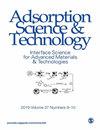A Strategy to Revalue a Wood Waste for Simultaneous Cadmium Removal and Wastewater Disinfection
IF 3.2
4区 工程技术
Q2 CHEMISTRY, APPLIED
引用次数: 4
Abstract
In this investigation, the possibility of wood waste (hardwoods such as oaks’ and alternatives’ staves from Balkan cooperage) revalorization for simultaneous cadmium removal and wastewater disinfection was examined. All samples were characterized in terms of their crystallinity index and crystallite size, amount of functional groups, and surface chemistry (determined by ATR-FTIR) as well as antibacterial activity. Mulberry is characterized by the lowest crystallinity index which can be ascribed to the highest crystallite size disabling crystallite denser packaging, while myrobalan plum has about 23% lower crystallite size that enables crystallite better packaging, thus resulting in a 42.4% higher crystallinity index compared to the mulberry. All oaks have a significantly higher amount of carboxyl groups compared to the alternatives (0.23-0.28 vs. 0.12-0.19 mmol/g). The adsorption experiments revealed that with increasing the initial cadmium concentration from 15 up to 55 mg/g, samples’ adsorption capacity increases by 89-220%. The equilibrium data fit well with the Langmuir isotherm model implying monolayer coverage of cadmium ions over a homogeneous wood surface. The relationship between the samples’ maximum adsorption capacities (ranged from 5.726 to 12.618 mg/g), their crystallinity index, and crystallite size was established. According to ATR-FTIR spectra, aldehyde, carboxyl, hydroxyl, and phenyl groups present on the wood waste surface are involved in Cd2+ adsorption which proceeds via the interplay of the complexation, cation-π interactions, and ion-exchange mechanisms. Mulberry and myrobalan plum showed about 89% and 80% of the total uptake capacity of cadmium within 60 min, while the equilibrium was attained after 240 min of contact time. Good compliance with pseudo-second kinetic order indicated that cadmium adsorption was mediated by chemical forces. Thermodynamic parameters revealed the spontaneous and exothermic character of cadmium ion adsorption onto mulberry and myrobalan plum. All studied samples provide maximum bacterial reduction (>99%) for E. coli and S. aureus. Wood waste from Balkan cooperage can be successfully used for simultaneous cadmium removal and wastewater disinfection.木材废弃物同时除镉和废水消毒的改造策略
在这项调查中,研究了木材废料(来自巴尔干合作社的橡树和替代木材等硬木)重新固化用于同时去除镉和废水消毒的可能性。所有样品的结晶度指数和晶体大小、官能团数量、表面化学(由ATR-FTIR测定)以及抗菌活性进行了表征。桑树的结晶度指数最低,这是由于桑树的结晶度最高,使其无法进行致密的包装,而梅的结晶度比桑树低23%左右,使其能够更好地进行包装,结晶度指数比桑树高42.4%。所有橡树的羧基含量均显著高于其他橡树(0.23-0.28 vs. 0.12-0.19 mmol/g)。吸附实验表明,当镉的初始浓度从15 mg/g增加到55 mg/g时,样品的吸附量增加了89 ~ 220%。平衡数据与Langmuir等温线模型吻合得很好,这意味着镉离子在均匀木材表面的单层覆盖。建立了样品的最大吸附量(5.726 ~ 12.618 mg/g)与结晶度指数、晶粒尺寸之间的关系。根据ATR-FTIR光谱,木材废料表面存在的醛、羧基、羟基和苯基参与了Cd2+的吸附,这种吸附通过络合作用、阳离子-π相互作用和离子交换机制的相互作用进行。桑树和梅对镉的吸收能力在60 min内分别达到89%和80%,而接触时间在240 min后达到平衡。良好的准二级动力学符合表明镉的吸附是由化学力介导的。热力学参数揭示了桑树和梅对镉离子的自发和放热吸附特性。所有被研究的样品对大肠杆菌和金黄色葡萄球菌的细菌去除率均达到最高(约99%)。巴尔干木材厂的木材废料可以成功地同时用于除镉和废水消毒。
本文章由计算机程序翻译,如有差异,请以英文原文为准。
求助全文
约1分钟内获得全文
求助全文
来源期刊

Adsorption Science & Technology
工程技术-工程:化工
CiteScore
5.00
自引率
10.30%
发文量
181
审稿时长
4.5 months
期刊介绍:
Adsorption Science & Technology is a peer-reviewed, open access journal devoted to studies of adsorption and desorption phenomena, which publishes original research papers and critical review articles, with occasional special issues relating to particular topics and symposia.
 求助内容:
求助内容: 应助结果提醒方式:
应助结果提醒方式:


